Agenda-setting intelligence, analysis and advice for the global fashion community.
Listen to and follow the ‘BoF Podcast’: Apple Podcasts | Spotify | Overcast
Background:
Instead of his usual place in the host’s seat, BoF founder and CEO Imran Amed appears this week as a guest in an interview with Jonathan Wingfield, editor-in-chief of System Magazine, alongside Luca Solca, senior research analyst at Bernstein — as featured in the debut issue of System Collections.
This conversation was recorded on March 14, about two weeks before Donald Trump’s shock announcement of so-called reciprocal tariffs on countries around the world, most notably China.
Together, Amed and Solca explore major shifts in the global luxury market, the growing fatigue with high prices and mass production, and why creativity, innovation and strategic alignment between business and creative leadership are more crucial than ever.
ADVERTISEMENT
“These companies are run by human beings, and if you don’t give people incentives to change, they will kill you. If you see that you’re making as much money as you like, and the business is as good as it ever was, then you probably will not change very much,” says Solca. “I think that adjusting to a more normal environment is causing a lot of soul-searching and is getting these companies back in line.”
Amed adds: “Where brands work best is where there is that impeccable alignment between the creative leadership and the business leadership. Many creative directors feel like a lot of decision-making and creativity is being dictated to them rather than being in conversation with them. And I think that’s what we need to see now.”
Key Insights:
- Excessive price hikes and product ubiquity are causing consumer pushback. Amed says, “When customers look at a €10,000 bag that used to cost half of that, there’s real pressure because the value proposition no longer adds up.” The industry’s future success depends on brands’ abilities to innovate and excite consumers. Solca stresses, “If people need to pay these prices, they must be excited; they need to feel they haven’t seen these products yet, and that they desire them.” Amed adds, “Brands need to inject new creative energy to get customers excited again.”
- In a stagnant market, luxury brands can no longer rely on organic demand and must instead compete aggressively for market share. “In order to grow now, brands need to actively win market share from competitors,” says Imran Amed. This shift has forced operational changes across the industry. “Fashion shows are getting smaller, not just for intimacy, but also to cut costs,” he adds. Luca Solca agrees: “You need to take into account that a lot of the costs in this industry are fixed ... When sales decline by as much as 20 percent, you really need to cut the fixed portion of your costs.”
- Maintaining exclusivity remains challenging yet essential. As Solca puts it, “The nature of the industry is that you need to sell exclusivity or perceived exclusivity.” He warns that high visibility can backfire for smaller brands: “We’ve seen it a number of times; smaller brands hit gold, but at one point, they succumb to that very success because they become too visible and people move elsewhere. They tend to be a bit of a flash in the pan or face a glass ceiling around €2 to 3 billion, which is very difficult to break through.”
- Effective luxury strategies hinge on strong creative-business collaboration. As Amed explains, “Where brands work best is where there is that impeccable alignment between the creative leadership and the business leadership.” He continues, “Many creative directors feel like a lot of decision making, a lot of creativity is being dictated to them rather than being in conversation with them. And I think that’s what we need to see now.”





